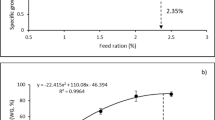Abstract
The efficiencies of four feeding methods were compared in the transition period from live food to dry feed in pikeperch (Sander lucioperca). Pond-nursed fry were trained to artificial feed without a transition (Group P) and with a transition, using a combination of dry feed and different kinds of live food—Chironomus larvae (Group C), Tubifex (Group T) and Daphnia (Group D)—during a 12-day-long trial. The ratio of dry feed for the transition groups was increased from 0 to 100% in 3-day intervals. The highest specific growth rates and condition factors were detected for Group C (4.2%, 1.46 ± 0.5) and Group T (4.2%, 1.48 ± 0.6), respectively. The survival percentages of the groups were as follows: 86.7 ± 9% (Group C), 78 ± 4% (Group T), 52 ± 1.4% (Group D) and 41 ± 9% (Group P). The rate of cannibalism ranged between 6.3 and 13.7% during the transition period. Larger-sized fish seemed to learn more rapidly to accept dry feed than their smaller counterparts.



Similar content being viewed by others
References
Antalfi A (1979) Propagation and rearing of pikeperch in pond culture. EIFAC Tech Paper 35:120–125
Beyerle GB (1975) Summary of attempts to raise walleye fingerlings on artificial diets, with suggestions on needed research and procedures to be used in future tests. Progr Fish Cult 37:103–105
Buijse AD, Houthuijzen RP (1992) Piscivory, growth and size-selective mortality of age 0 pikeperch (Stizostedion lucioperca). Can J Fish Aquat Sci 49:894–902
Chesire WF, Steele KL (1972) Hatchery rearing of walleyes using artificial food. Progr Fish Cult 34:96–99
Frankiewicz P, Dabrowski K, Martyniak A, Zalewski M (1999) Cannibalism as a regulatory force of pikeperch, Stizostedion lucioperca (L.), population dynamics in the lowland Sulejow reservoir (Central Poland). Hydrobiologia 409:47–55
Hilge V (1990) Beobachtungen zur Aufzucht von Zandern (Stizostedion lucioperca) im Labor. Arch Fischereiwissenschaft 40:167–173
Horváth L, Tamás G, Tölg I (1984) Pike-perch culture. In: Halver JE (ed) Special methods in pond fish husbandry. Akadémiai Kiadó, Budapest and Halver Corporation, Seattle, pp 140–141
Klein Breteler JGP (1989) Intensive culture of pikeperch fry with live food. In: De Pauw N et al (eds) Aquaculture—a biotechnology in progress, vol. 1. European Aquaculture Society, Bredene, pp 203–207
Kuipers KL, Summerfelt RC (1994) Converting pond-reared walleye fingerlings to formulated feeds: effect of diet, temperature and stocking density. J Appl Aquacult 4:31–57
Molnár T, Hancz C, Bódis M, Müller T, Bercsényi M, Horn P (2004) The effect of initial stocking density on the growth and survival of the pike-perch fingerling reared under intensive conditions. Aquacult Int 12:181–189
Nagel T (1976) Intensive culture of fingerling walleyes on formulated foods. Progr Fish Cult 38:90–91
Steffens W (1960) Ernahrung und Wachstum des jungen Zanders (Lucioperca lucioperca) in Teichen. Z Fisch N.F. 9:161–271
Steffens W, Geldhauser F, Gerstner P, Hilge V (1996) German experiences in the propagation and rearing of fingerling pikperch (Stizostedion lucioperca). Ann Zool Fenn 33:627–634
Szkudlarek M, Zakęś Z (2002) The effect of stocking density on the effectiveness of rearing pikeperch (Sander luciperca) summer fry. Arch Polish Fish 10:115–119
Tölg I (1962) Reasons of the lack of pike perch food in Lake Balaton and plans for comensation (in Hungarian with German summary). Állattani Közlemények 49:131–140
Tölg I (1981) Fortschritte in der Teichwirtschaft: Spezielle Methoden (with the collaboration of L. Horváth and G. Tamás). Paul Parey, Hamburg, Berlin
Van Densen WLT (1985) Piscivory and the development of bimodality in the size distribution of 0+ pikeperch (Stizostedion lucioperca L.). J Appl Ichtyol 3:119–131
Van Densen WLT, Vijverberg J (1982) The relations between 0+ fish density, zooplankton size and the vulnerability of pikeperch, Stizostedion lucioperca, to angling in the Frisian lakes. Hydrobiologia 95:321–336
Verreth J, Kleyn K (1987) The effect of biomanipulation of the zooplankton on the growth, feeding and survival of pikeperch (Stizostedion lucioperca) in nursing ponds. J Appl Ichthyol 3:13–23
Woynárovich E (1960) Aufzucht der Zandernlarven bis zum Raubfischalter. Z Fisch N. F. 9:73–83
Zakęś Z (1997) Converting pond-reared pikeperch fingerlings, Stizostedion lucioperca (L.) to artificial food—effect of water temperature. Arch Polish Fish 5:313–324
Zakęś Z (1999) The effect of body size and water temperature on the results of intensive rearing of pikeperch, Stizostedion lucioperca (L.) fry under controlled conditions. Arch Polish Fish 7:187–199
Zakęś Z, Szczerbowski A (1995) Characteristics of autumn fry of pikeperch (Stizostedion lucioperca) reared in a traditional way in pond and in controlled conditions. Arch Polish Fish 3:159–168
Zakęś Z, Demska-Zakęś K (1996) Effects of diets on growth and reproductive development of juvenile pikeperch, Stizostedion lucioperca, reared under intensive culture conditions. Aquat Res 27:841–845
Acknowledgements
This study was carried out at the Makkos and Co. Fish Farm, Fonyód, Hungary and was funded by the Széchenyi Program of the Hungarian Government and by an OTKA T17 48289 grant.
Author information
Authors and Affiliations
Corresponding author
Rights and permissions
About this article
Cite this article
Bódis, M., Kucska, B. & Bercsényi, M. The effect of different diets on the growth and mortality of juvenile pikeperch (Sander lucioperca) in the transition from live food to formulated feed. Aquacult Int 15, 83–90 (2007). https://doi.org/10.1007/s10499-006-9063-0
Received:
Accepted:
Published:
Issue Date:
DOI: https://doi.org/10.1007/s10499-006-9063-0




